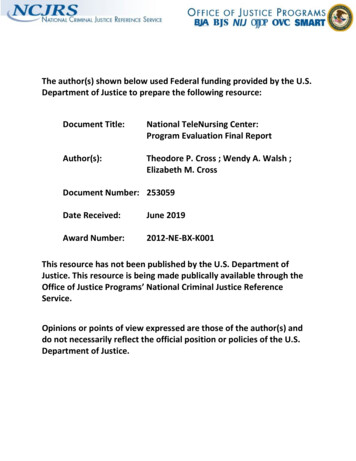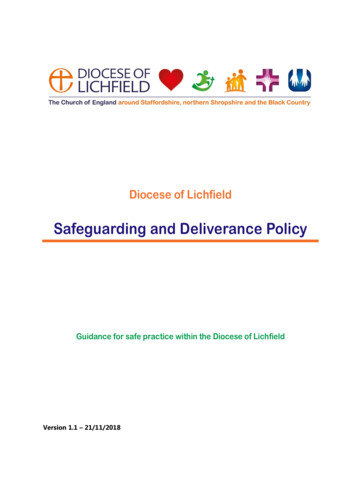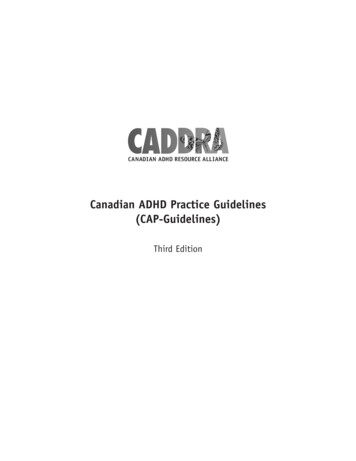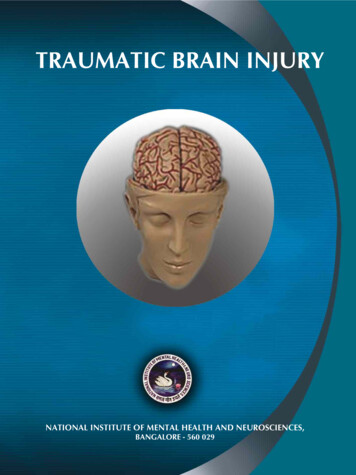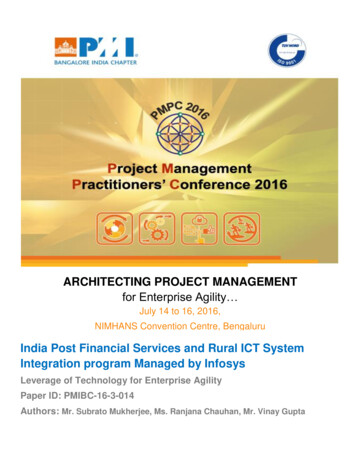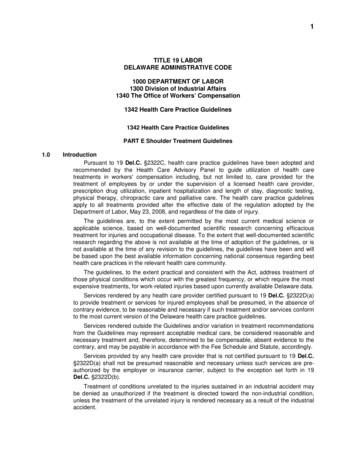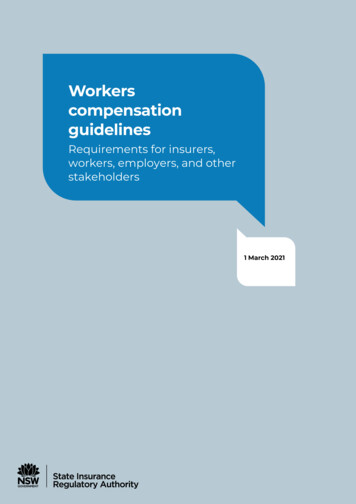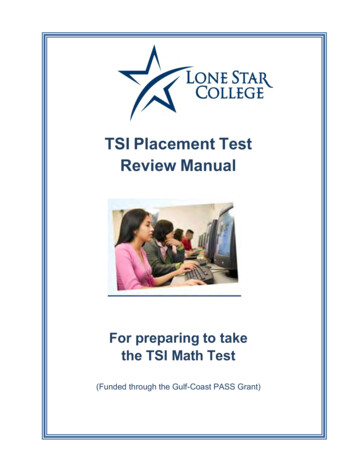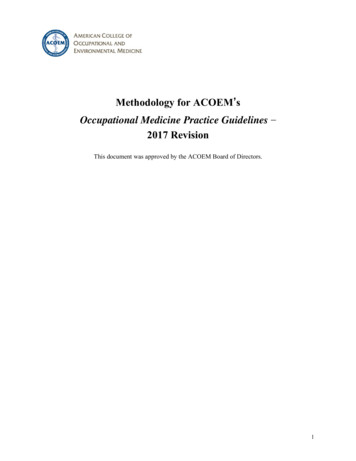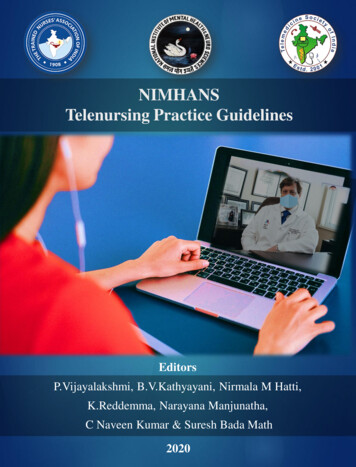
Transcription
NIMHANSTelenursing Practice GuidelinesEditorsP.Vijayalakshmi, B.V.Kathyayani, Nirmala M Hatti,K.Reddemma, Narayana Manjunatha,C Naveen Kumar & Suresh Bada Math2020
NIMHANSTelenursing Practice GuidelinesCollege of Nursing & Telemedicine CentreNational Institute of Mental Health and Neuro Sciences,(Institute of National Importance)Bengaluru – 560029In association withTelemedicine Society of India&Trained Nurses' Association of IndiaCopyright NIMHANS, Bengaluru -5600292020
EditorsDr. P.Vijayalakshmi, PhDCollege of Nursing, National Institute of Mental Health and Neuro Sciences,(Institute of National Importance), Bengaluru – 560 029Email:- pvijayalakshmireddy@gmail.com, vijayalakshmiporeddy@yahoo.co.inPhone: - 0802699 5818Dr. B.V.Kathyayani, PhDProfessor & Principal, College of Nursing,National Institute of Mental Health and Neuro Sciences,(Institute of National Importance), Bengaluru – 560 029Ms. Nirmala M Hatti, MSc(N)I/C Head of Clinical Services, National Institute of Mental Health and NeuroSciences, (Institute of National Importance), Bengaluru – 560 029Dr.K.Reddemma, PhDFormer Senior Professor& DeanNational Institute of Mental Health and Neuro Sciences, (Institute of NationalImportance) & Nodal Officer, National Consortium for Ph.D in Nursing, St JohnsCollege of Nursing, Sarjapur Road, Bangalore - 560 034Dr. Narayana Manjunatha, DPM, MDAssociate Professor of Psychiatry, Department of Psychiatry,Consultant, Tele-Medicine Centre, National Institute of Mental Health and NeuroSciences, (Institute of National Importance), Bengaluru – 560029Dr. C Naveen Kumar, DPM, MD, MAMSProfessor of Psychiatry, Head, Community Psychiatry Unit,Consultant, Centre for Disaster Management, Forensic Psychiatry, Legal Aid Clinic &Tele-Medicine Centre, Department of Psychiatry, National Institute of Mental Healthand Neuro Sciences, (Institute of National Importance), Bengaluru – 560029Dr. Suresh Bada Math, MD, DNB, PGDMLE, PGDHRL, PhD in Law (NLSIU)Professor & Head of Forensic Psychiatry Services,Head of Tele-Medicine Centre and Unit-V (Psychiatry),Consultant, Community Psychiatry, Department of Psychiatry,National Institute of Mental Health and Neuro Sciences, (Institute of NationalImportance), Bengaluru – 560 029
Published by National Institute of Mental Health and Neuro Sciences, Bengaluru-560 029All rights reserved. No part of these guidelines may be reprinted or distributed or utilized inany form or by any means including photocopying and recording, or in any information storageor retrieval system, without permission in writing from the authors for commercial purposes.However, this document may be freely reviewed, freely transmitted, reproduced in part orwhole, purely on non-commercial basis with proper citation. This is not for sale.First Edition – 2020Copyright NIMHANS, Bengaluru-560 029ISBN: 978-81-948111-9-0NIMHANS Publication No. 186Disclaimer: Health information technology is evolving rapidly. This guideline reflects the bestavailable data at the time this guideline was prepared. While all attempts have been made toverify the accuracy of the information provided in this guideline, neither the authors nor thepublisher nor any other party who has been involved in the preparation or publication of thiswork assumes no responsibility for any errors or omissions or for the results. This Telenursingguideline is drafted to work in sync with Telemedicine Practice guidelines-2020, of the IndianMedical Council (Professional Conduct, Etiquette and Ethics Regulation, 2002) now under theNMC Act, 2019Citation: Vijayalakshmi Poreddi, Kathyayani BV, Nirmala M Hatti, Reddemma K, NarayanaManjunatha, Naveen Kumar C & Suresh Bada Math (2020). NIMHANS-Telenursing PracticeGuidelines-2020. Pub; NIMHANS, Bengaluru-560 029.Correspondence:Dr. P.Vijayalakshmi PhDCollege of Nursing, National Institute of Mental Health and Neuro Sciences,(Institute of National Importance), Bengaluru – 560 029Email:- pvijayalakshmireddy@gmail.com, vijayalakshmiporeddy@yahoo.co.inPhone: - 0802699 5818
THE TRAINED NURSES' ASSOCIATION OF INDIA (TNAI)ESTD.IN 1908Registered under the Societies Act XXI of 1860 in 1917.WWW.TNAIONLINE.ORG
Telemedicine Society of IndiaTelemedicine Society of India HQRegistered under Societies Registration Act, 1860.Regd. Office: Room No.303. 2nd Floor, School of Telemedicine & Biomedical Informatics (STBMI)SGPGIMS, Raibareli Road, Lucknow. Uttar Pradesh-226014. India.PRESIDENT (2019-2020)Maj. Gen. (Dr.) Ashok Kumar Singh(Retd.)RajasthanMessageInformation and communication technology have led to a global revolution in the healthcaresystem. In India, two-thirds of its population predominantly live in a rural area with immenseIMMEDIATE PASTPRESIDENT (2019-2020)Mr. Vimal WakhluNew DelhiPRESIDENT ELECT (2019-2020)Colonel (Dr) Ashvini Goel (Retd)New Delhihealth care needs. Congruently, India has an acute shortage of health care providers. TheIndian government is committed to strengthening the healthcare system and lays a significantfocus on the use of telemedicine services, especially in the Health and Wellness Centres atthe grassroot level wherein the nurses can connect the patients and their families to theappropriate health services to receive timely and the best possible care.Telenursing is an emerging field that uses innovative technologies to improve the standardsVICE PRESIDENT (2019-2020)Prof. P.K. PradhanUttar Pradeshof nursing. However, it doesn’t alter the nature of professional practice. Telenursing ensuresthat nurses are more ubiquitous and have a greater involvement in primary care. I am glad toknow that the College of Nursing has developed comprehensive guidelines in collaborationCHIEF OPERATING OFFICER (COO)Mr. Baljit Singh BediNew Delhiwith the Telemedicine Center, Department of Psychiatry, NIMHANS, Bengaluru to offerpractical advice to nursing professionals in India. I am sure that these guidelines provide aclear direction to the registered nurses to enhance their ability to provide safe, competent,HONY. SECRETARY (2019-2021)Dr. Murthy RemillaKarnatakaJOINT SECRETARY-CUM-HON.TREASURER (2019-2021)Mr. Repu Daman ChandUttar Pradeshcompassionate and ethical care. However, it is important to note that these guidelines willrequire ongoing updates in response to the ever-changing nature of technology.The Union Health Ministry's eSanjeevani OPD platform has completed five lakh teleconsultations within six-months since its launch on April 13 with the last one lakhconsultations being done in a record time of 17 days. The eSanjeevani OPD services haveenabled patient-to-doctor telemedicine in the midst of the COVID-19 pandemic. I appreciateEXECUTIVE COMMITTEEMEMBERS (2019-2021)Dr. Sibananda Mohanty, OdishaMr. D. Satheesh KumarTamil NaduMr. Farooq Ahmad WaniJammu & Kashmirand congratulate all the stakeholders for their relentless efforts in bringing out theseguidelines. I also look forward to the early and effective implementation by the nurses acrossthe nation. This tele-nursing guidelines from NIMHANS will be play the catalyst role intaking the much-needed healthcare to the rural area through Health and Wellness centresacross the country reaching the unreached.Mr. Bijoy. MG, KeralaMs. Nishu Tyagi, New DelhiMr. Shiv Mishra, Uttar PradeshBagmisikha Puhan, Legal AdvisorNew DelhiMaj. Gen. (Dr.) Ashok Kumar Singh (Retd.)PresidentTelemedicine Society of IndiaContact: Telephone 91 522 2668838, 91 522 2495530Fax: 91 522 2668893 email: contact@tsi.org.in, hon.secretary.tsi@gmail.com & joint.secy.tsi@gmail.comWebsite: www.tsi.org.in
S. No1ContentBackgroundPage No11.1. Definitions and applications1.1.1. Telehealth1.1.2. Telemedicine1.1.3. Telenursing1.1.4. Registered Nurse1.1.5. Registered Auxiliary Nurse & Midwife1.2. Scope of Guidelines1.3. Qualifications required to practice telenursing2Technology and mode of Communication63Etiquette for Telenursing Practice114Guidelines for Telenursing Practice145Framework for Telenursing practice225.1. Consultation between a registered nurse and registered medicalpractitioner at an SHC (Sub health Center) Health &Wellness Center5.2. Consultation between a registered nurse and registered medicalpractitioner at a PHC (Primary Health Center) Health &Wellness Center5.3. Consultation between a registered nurse and registered medicalpractitioner in a community setting5.4. Consultation between a registered Nurse and registered medicalpractitioner in an emergency5.5. Other Situations6AnnexuresAssessment formsConsent formReferencesReviewers41
AbbreviationsALS: Advanced Life supportANM: Auxiliary Nurse MidwifeASHA: Accredited Social Health ActivistBLS: Basic Life SupportCHC: Community Health CenterEMS: Emergency Medical ServicesHWC: Health &Wellness CenterICN: International Council of NursesINC: Indian Nursing CouncilMLHP: Mid-Level Health ProviderPHC: Primary Health CenterRANM: Registered Auxiliary Nurse MidwifeRMP: Registered Medical practitionerRN: Registered NurseSHC: Sub Health CenterSMS: Short Message ServiceSOP: Standard Operating ProcedureVoIP: Voice over Internet ProtocolWHOWorld Health Organization
NIMHANS-TELENURSING PRACTICE GUIDELINESBACKGROUNDTelemedicine (healing from a distance) is an emerging field in India. India is a developingcountry with 138 crores of the population having limited health care facilities. Furthermore,two-thirds of its population lives in remote rural areas and are unable to access health careservices. In this context, telemedicine is a boon for health care providers in bridging thetreatment gap between rural and urban India. Under the health initiative Ayushman Bharat, theIndian government is committed to providing comprehensive health care services to citizens inevery corner of the country through Health &Wellness Centers (HWCs). Health and WellnessCenters are digitally connected with hubs at district hospitals and medical colleges to enablethe access of specialist services from hubs to the patients.The ‘e-Sanjeevani’ is a telemedicine service that is implemented under the Ayushman Bharathealth initiative at the Health and Wellness Centers. The ‘e-Sanjeevani’ is gradually shapinginto a parallel stream for the Indian healthcare delivery system as it is equally accepted by bothpatients and health care providers. Congruently, ‘e-Sanjeevani OPD-Stay Home OPD’ appenabled teleconsultation between patients and doctors in the midst of the COVID-19 pandemichas been a welcome initiative. This teleconsultation platform not only contained the spread ofCOVID-19 infection by ensuring physical distancing but also helped the patients in receivingessential health care services.At the Sub-Center level, Health &Wellness Centers are led by Mid-level health providers(MLPs) who may be a registered nurse or an Ayurveda practitioner. Nurses being a majorworkforce in the health care system help offer health care services to people in rural areas. Inrural India, people are neither able to access nor afford their health care requisites such asspecialist’s opinion and tertiary care services. In this context, nurses who work at Health&Wellness Centers play an important role in enabling this disadvantaged population to receiveappropriate health care through telemedicine consultation. Hence, telenursing needs to beintegrated into the health care system to enhance and not replace existing healthcare services.Globally, telenursing offers unlimited opportunities to its members to propel the nursingprofession forward. Yet, in India telenursing is not well established. Few initiatives oftelenursing in India include; conducting webinars to create awareness among nursingprofessionals during the COVID-19 pandemic, the Indian Nursing council uses telenursing forthe Ph.D. program since 2006, the Department of Nursing at NIMHANS has been training and1 PageNIMHANS -2020
conducting patient case discussions with District Mental Health Program (DMHP) nurses inKarnataka and Bihar through telenursing since 2017 and PGIMER Chandigarh is educatingnurses from Nepal and Afghanistan. Hence, there is an urgent need to establish telenursing asa regular practice, given that it saves time, is cost-effective, and is accessible in emergencytimes such as the Covid-19 pandemic.According to the recent telemedicine practice guidelines by the Indian Medical Council,telehealth can transform the health care system and provides equal access to quality of care toall. Furthermore, in the case of a pandemic like COVID-19, it is the need of the hour for peopleto consult health care professionals through the internet or videoconferencing for variousreasons. Thus, telenursing shall have a significant impact on overcoming some of the healthcare challenges such as access to care, cost-effective delivery, and unequal distribution ofhealth care providers.Currently, there are no legislations or guidelines that exist in India on the practice oftelenursing. The current guidelines were developed based on professional norms and standardsto enable nurses to practice telenursing in Indian settings.PurposeThe purpose of this document is to provide general guidelines to registered nurses about theuse of telehealth technology. These guidelines would help registered nurses in identifying theirroles and responsibilities to provide professional, safe, compassionate, competent and ethicalcare. This guideline is developed keeping in mind both private and public health establishment.These telenursing guidelines were developed based on the Code of Ethics and ProfessionalConduct for nurses in India. Therefore, it provides a clear direction for registered nurses topractice telenursing within their professional boundaries. In these guidelines, the terms ‘Nurse’and ‘Registered Nurse’ are used interchangeably.These guidelines would also help nurses on how to collaborate with specialist doctors,professional colleagues, and other health care team members in offering the best possible care,on time. These guidelines act as a framework to enable nurses to adhere to ethical andprofessional norms and direct them to be accountable for the care offered by them. However,these guidelines should be used in conjunction with other national clinical standards, protocols,policies, and procedures.2 PageNIMHANS -2020
1. TELENURSING: DEFINITIONS AND APPLICATIONS1.1. DEFINITIONS1.1.1. TelehealthThe World Health Organization (WHO,2016) defines telehealth as“Delivery of health care services, where patients and providers are separated bydistance. Telehealth uses information and communications technology (ICT) for theexchange of information for the diagnosis and treatment of diseases and injuries,research and evaluation, and for the continuing education of health professionals.Telehealth can contribute to achieving universal health coverage by improving accessfor patients to quality, cost-effective, health services wherever they may be. It isparticularly valuable for those in remote areas, vulnerable groups, and agingpopulations.”1.1.2. TelemedicineWorld Health Organization (1998) defines telemedicine as“The delivery of health-care services, where distance is a critical factor, by all healthcare professionals using information and communications technologies for theexchange of valid information for the diagnosis, treatment, and prevention of diseaseand injuries, research and evaluation, and the continuing education of health-careworkers, with the aim of advancing the health of individuals and communities.”1.1.3. TelenursingAccording to the International Council of Nurses (ICN,2009), telenursing is“the use of telecommunications technology in nursing to enhance patient care. Itinvolves the use of electromagnetic channels (e.g. wire, radio, and optical) to transmitvoice, data, and video communications signals.”1.1.4. Registered Nurse (RN)For the purpose of these guidelines, a “Registered Nurse and Midwife” is defined as“an individual who has completed minimum General Nursing and Midwifery (GNM)course or BSc in Nursing course (BSc N) and has enrolled in the State Nursing Councilor Indian Nursing Council under the Indian Nursing Council Act, 1947”.3 PageNIMHANS -2020
1.1.5. Registered Auxiliary Nurse & Midwife (R.ANM)For these guidelines, a “Registered Auxiliary Nurse and Midwife” (R.ANM) or “JuniorHealth Assistant” is defined as“an individual who has completed the Auxiliary Nurse Midwifery course and haveenrolled in State Nursing Council and Indian Nursing Council under the IndianNursing Council Act 1947”.1.2. SCOPEThese telenursing practice guidelines will be published under the INC Act, 1947. Theseguidelines are developed to enable nurses and midwives in India in adopting and utilizing thetelenursing concept in their professional practice to provide optimal care. These guidelines are intended for Registered Nurses and Registered Auxiliary Nurse &Midwives (RN&R. ANMs) under the INC Act 1947. These guidelines were developed based on the professional norms and standards ofpractice recommended by the Indian Nursing Council, Trained Nurses Association ofIndia, and the International Council of Nurses. The review of other relevanttelemedicine practice guidelines was taken into consideration. Telenursing like telemedicine includes all channels of communication with the patientthat leverage Information Technology platforms, including Voice, Audio, Text &Digital Data exchange. These guidelines also can be utilized to educate health care workers in various aspectsto update their knowledge.ExclusionsThe guidelines exclude the following: Data management systems involved; standards and interoperability. Use of digital technology and artificial intelligence to carry out specific nursingprocedures (Insertion of intravenous infusions, conducting deliveries, etc). Provide for consultations out of the professional boundaries Provide for tele-consultations outside the jurisdiction of India4 PageNIMHANS -2020
1.3. QUALIFICATIONS REQUIRED TO PRACTICE TELE NURSINGAt the National Institute of Mental health and Neuro Sciences Bengaluru, the registeredNurses must undergo an online course/training on the practice of telenursing.1.3.1. Registered Nurses are entitled to provide telenursing consultation to patients from acrossIndia both in private and public health establishments.1.3.2. Registered Nurses who practice telenursing shall uphold the same professional andethical norms, laws and clinical standards consistent within the scope of professionalorganizations (i.e., as outlined in various policy documents such as the Indian NursingCouncil Act, Code of ethics and professional standards for nurses in India and positionstatements by Trained Nurses Association of India).1.3.3. Understanding the core principles which are discussed in these guidelines enables thenurses to sustain professional, legal, and ethical integrity in offering telenursing care.5 PageNIMHANS -2020
2. TECHNOLOGY AND MODE OF COMMUNICATION2.1. TECHNOLOGY USED IN TELE NURSING PRACTICE2.1. TECHNOLOGY USED IN TELE NURSING PRACTICETelenursing has evolved as an important branch of telemedicine. The essential technology toolsrequired for Telenursing include:2.1.1. Dedicated Office Mobile /Landline number and Email IDIt is preferable to consider having a dedicated work phone/ office mobile line number/professional social media account/Email ID to provide telenursing services. This helpsthe nurses in communicating with their clients effectively.2.1.2. Internet ConnectionSecure and dependable internet connectivity is a prerequisite for a successfultelenursing experience. A range of healthcare-related activities such as videoconferencing, accessible health care records, emails, uninterrupted communications,and so on, are largely based on network performance. It is advisable to have at least twointernet service providers to ensure incessant communication with patients or healthcare providers. A wired connection through an ethernet cable is less prone tointerruptions. However, Wi-Fi technology has improved a lot. Yet individuals have toremember not to move away from the range of the router. A general rule of thumb inWi-Fi networking is that Wi-Fi routers operating on the 2.4 GHz band which can reachup to 150 feet indoors and 300 feet outdoors. But this further reduces, if there areconcrete walls and acoustic walls (soundproof walls). Therefore, it is necessary to bewithin the range of a Wi-Fi router to provide telenursing services and if required, installa Wi-Fi range extender.2.1.3. Computer systemA computer system comprises of two major elements namely hardware and software.Computer hardware is the collection of physical parts that can be recognized easilysuch as a keyboard, monitor, mouse, etc. In contrast, computer software is a set ofinstructions to perform specific operations. For example, computer programs, onlinedocumentation, digital media, etc. However, both computer hardware and softwarerequire each other, and neither can function independently.6 PageNIMHANS -2020
2.1.4. HardwareThe most common types of hardware used in Telenursing consultations include, desktopand laptop computers and tablets.2.1.4.1. Desktop computerA desktop computer is a personal computer, consisting of a Central Processing Unit(CPU), keyboard and a mouse. This type of computer is not portable due to its size andpower requirements.2.1.4.2. Laptop computerA laptop computer has the same hardware components but is integrated into a singleportable unit.2.1.4.3. Tablets and mobile devicesTablets, such as iPads, are often used in emergency services and other healthcare areas.Health care professionals (doctors and nurses) were the early adopters of tablets andsmartphones due to their portability and advanced features. The majority of health careconsumers are also able to use mobile phones effectively for video and audioconferencing with health care providers. Mobile technology allows an instantconnection between the consumers and healthcare professionals to provide convenientcare regardless of the location.2.1.5. SoftwareNurses may choose software applications that are simple, easily adaptable, and canprovide uninterrupted communication with their clients. It is also important to choose thesoftware applications which are most commonly used by the general public.Telemedicine practice guidelines (2020) and telepsychiatry operative guidelines (2020)also suggested the use of social media such as WhatsApp, Skype, Facebook, and so forthwhich are popular among the general public.2.1.6. Digital cameraDigital camera technology allows a simple, inexpensive telenursing experience. It is anessential component of telenursing consultations. Thus, it is essential to have high-end,high-resolution digital cameras as they allow nursing professionals to take clear images7 PageNIMHANS -2020
and share them with specialists at different locations. The way nurses present themselveson camera is extremely important during video consultations. Therefore, the camera hasto be placed at eye-level. Active listening and maintaining eye contact (looking at thecamera) is important to build rapport with the patients. If nurses are taking notes onhistory collection or complaints, it is necessary to keep the patients informed, lest thatbehavior be mistaken as distraction on part of the nurse.2.1.7. InfrastructureThe infrastructure of the teleconsultation room should create an environment that allowsnursing professionals to use technology in offering care to patients in remote areas.2.1.7.1. LocationThe room should be set up in a quiet location to avoid noise exposure. It is importantto remember that, sound can be easily picked up by microphones and create difficultyin hearing for the remote participants. Preferably, the room should be situated awayfrom noisy hallways, waiting rooms or restrooms and air-conditioners, to enable bettersound quality. If possible, it is wise to select a windowless room to obtain better imagequality and ensure privacy. Rooms with windows should have curtains or screens.2.1.7.2. Room sizeThe teleconsultation room should be large enough as it affects the camera’s field of view.This distance between the two walls may vary according to the type of clinical servicebeing provided. Sometimes nurses would like to focus on the full view of the patient oronly the relevant body part. So, the nurses need to select the room size accordingly.2.1.7.3. Room designThe room should be designed in such a way to allow the nursing staff to enter and exiteasily without disrupting the consultation process. There should be a facility to indicateany technical problems that exist during telenursing consultation.2.1.7.4. Location of windowsThe clients or nursing professionals should not sit with their back against the windowas this causes backlighting and reduces image quality. If this is not possible, curtainsshould be fixed to reduce the backlighting effect. It is also recommended to use lightblue or light grey colors on the walls to reduce the impact of lighting.8 PageNIMHANS -2020
2.2. MODE OF COMMUNICATION2.2. MODE OF COMMUNICATIONAccording to telemedicine guidelines (2020), Video, Audio, or Text (chat, messaging, email,fax, etc.) are the primary modes of communication. However, each one of these modes hastheir respective strengths and weakness with respect to offering appropriate nursing care. It istherefore important to understand the strengths, benefits as well as limitations of differenttechnologies.9 PageNIMHANS -2020
STRENGTHS AND LIMITATIONS OF VARIOUS MODES OF COMMUNICATIONModeStrengthsVIDEO:Telemedicine facility,Apps,Video on chat platforms,Facetime etc. AUDIO: Phone,VOIP,Apps etc. LimitationsClosest to an in person-consult, Is dependent on the high-quality internetreal-time interactionconnection at both ends, else will lead toPatient identification is easiera sub-optimal exchange of informationNurses can see the patient and Since there is a possibility of abuse/misuse, ensuring the privacy of patientsdiscuss with the caregiver andspecialist doctorsin video consults is extremely importantVisual cues can be perceivedInspection of the patient can becarried outConvenient and fastUnlimited reachSuitable for urgent casesNo separate infrastructure requiredPrivacy ensuredReal-time interaction. Non-verbal cues may be missed Not suitable for conditions that require avisual inspection (e.g. skin, eye, tongueexamination), or physical touch Patient identification needs to be clearer,greater chance of imposters representingthe real patientTEXT BASED: Specialized Chat-based TelemedicineSmartphone Apps, SMS,WhatsApp, Google Hangouts, FacebookMessenger Convenient and quick Besides the visual and physical touch,Documentation & Identificationtext-based interactions also miss theverbal cuesmay be an integral feature of theplatform Difficult to establish rapport with thepatient.Suitable for urgent cases, or followups, consult with nurse colleagues, Cannot be sure of the identity of thespecialist doctors, and othershealth care providers or the patientNo separate infrastructure required,Can be real-timeASYNCHRONOUS:EmailFax, recordings, etc. Convenient and easy to document No specific app or downloadrequirement Images,shared No separate infrastructure required More useful when accompanied bytest reports and follow up andsecond opinionsdata,reportsreadily Not a real-time interaction, so just oneway context is available, relying solely onthe articulation by the patient Patient identification is document-basedonly and difficult to confirm Non-verbal cues are missed There may be delays because the healthcare providers may not see the mailimmediatelyVoIP-Voice over Internet Protocol, SMS-Short Message Service (Adopted from TelemedicinePractice Guidelines 2020)10 P a g eNIMHANS -2020
3. ETIQUETTE FOR TELENURSING PRACTICEThis section deals with expected professional behaviors in telenursing practice. The list givenbelow is not exhaustive, rather, it includes some primary considerations for a successfultelenursing consultation.Do’sThe RN ShouldDon’tsThe RN should notEnvironmentTest the equipment (camera, internet microphones,speakers, etc) before a teleconsultation.Know where to get technical assistance.Clutter the teleconsultation room.Always have an alternate communication channel.Worry if technology fails.Ensure privacy.Conduct telenursing consultation in noisy andopen areasAdjust the camera at eye level.Look at the patient’s face. Eye to eye contact ismade with the patient by looking at the camera.Ensure adequate light to visualize the patients.Sit next to windowsProfessional attireWear comfortable and neutral-colored clothesWear bright or fluorescent colored clothes.Effective communicationUse a pleasant and normal tone of voice.Shout or mumble to self.Greet the patient, introduce self, and identify theperson to whom they are speaking.Blindly proceed with the teleconsultation. Identifythe patient with valid documents.Inform the clients about the telenursing process andcommunication issues before their initial telehealthencounter.Give long explanations.Listen actively without interrupting the clientsSpeak to patients while they are talking (waitabout two seconds).Offer factual information.Make premature conclusions concerning patients’health conditions.Speak in lay language.Use complicated medical terms.11 P a g eNIMHANS -2020
Engage the patient.Nod and use open and attentive body language such asleaning towards the cameraShow any signs of stress or impatience as thesefacial expressions may not encourage patients toexpress themselves.Observe for verbal, emotional and behavioral cues thatcan convey important client information (e.g., tone ofvoice, background noise, body language)Eat, drink or chew gum during a telehealth sessionAsk open-ended questions in a logical sequence toelicit patient-related informationUse closed-ended questionsEnd the conversation with appropriate pleasantries.Example: thank you, have a nice day, wish you speedyrec
nurses from Nepal and Afghanistan. Hence, there is an urgent need to establish telenursing as a regular practice, given that it saves time, is cost-effective, and is accessible in emergency times such as the Covid-19 pandemic. According to the recent telemedicine practice guidelines by the Indian Medical Council,
